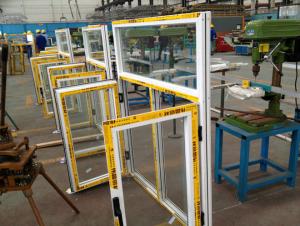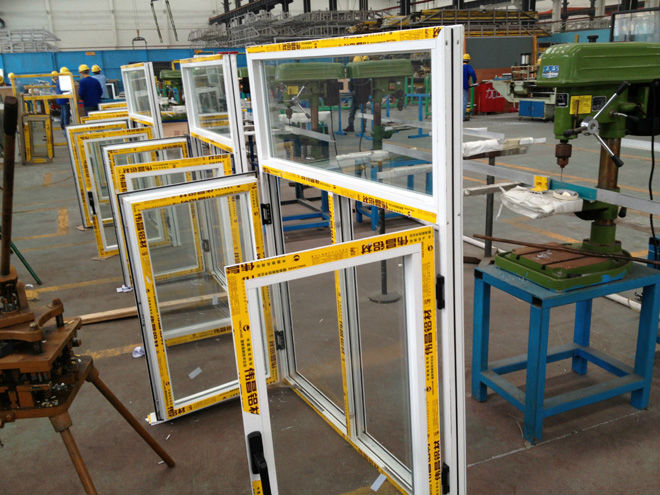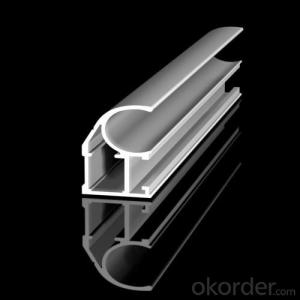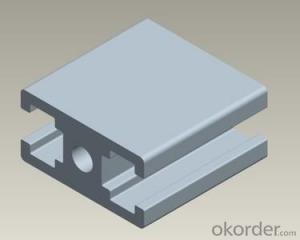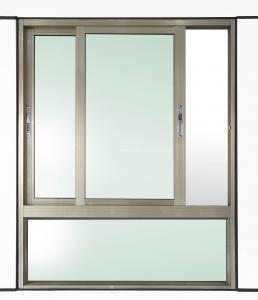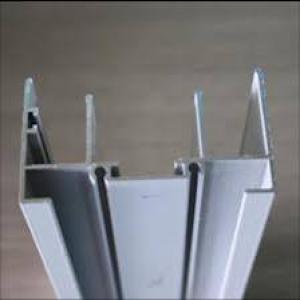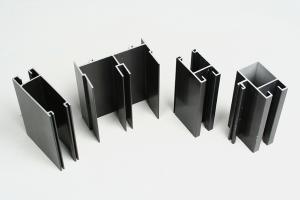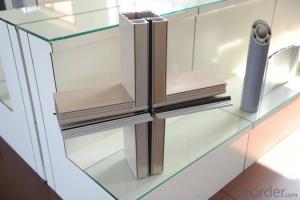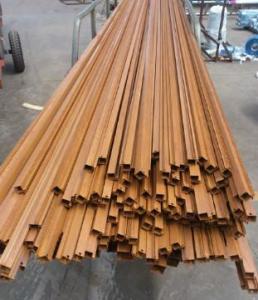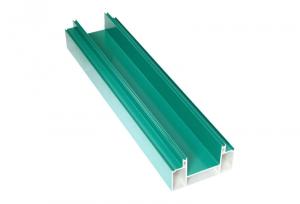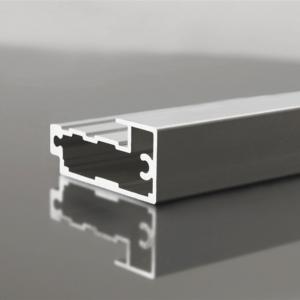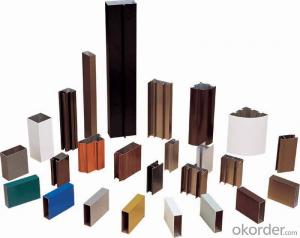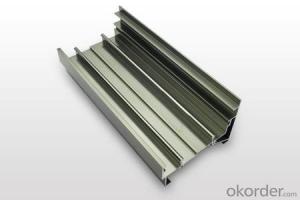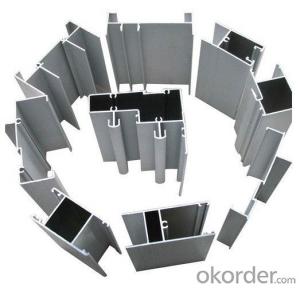Solidworks Aluminum Extrusion Profiles for Windows
- Loading Port:
- China Main Port
- Payment Terms:
- TT OR LC
- Min Order Qty:
- -
- Supply Capability:
- -
OKorder Service Pledge
OKorder Financial Service
You Might Also Like
Aluminium Profile
1)Material : 6063 6061 6060 and different aluminium alloy
2)Status:T4 T5 T6 or other special status
3)Surface treatment: mill finish, anodized sliver ,anodized bronze, anodized champagne, anodized black pearl, various power coating color, electrostatic sliver, electrostatic champagne, electrostatic golden, electrostatic titanium , machine polish sliver, machine polish bronze, wooden grain color, and Fluorocarbon spraying.
4)Annual capacity : 120000TON
5)Quality : China Nation Standard GB/T 5237 2008 (advanced class)
6)Use: can be widely using aluminium window, door, curtain wall, hand railing , normal aluminium profile, decorative and industrial aluminium profile
7)Advantage: Famous Brand reasonable&market price, soonest delivery and good after sale- service
8)Type of package:protection foam+heat contracted plastic film. / wooden packing / Metal pallet or depand on clientspecial requirement.
9)Payment term:T/T:30% of total value as deposite should paid by T/T within 3 days when confirmation ,and the remaining sum should be paid by T/T before delivery.L/C: 100% at sight
10)Delivery Day: 15-30days
11)Honor : CHINA FAMOUS TRADEMARK, CHINA TOP BRAND, ISO9001-2000, CHINA SQUARE&ROUND COMMITTEE DNV
- Q: This question asks about the various types of aluminum profiles that are utilized in the construction of insulation systems.
- <p>Aluminum profiles used for building insulation come in various types, each serving specific functions. These include: 1. Insulation profiles, which provide a thermal barrier; 2. Structural profiles, used for structural support; 3. Cover profiles, which protect the insulation material; 4. Joint profiles, used for sealing joints; 5. Corner profiles, for reinforcing corners; 6. Edge profiles, for finishing edges; and 7. Special profiles, designed for specific applications. Each type is engineered to enhance thermal efficiency and structural integrity in building insulation systems.</p>
- Q: Can aluminum profiles be used in curtain wall systems?
- Indeed, curtain wall systems have the capacity to incorporate aluminum profiles. Such systems usually consist of lightweight materials that provide structural support while simultaneously permitting ample natural light to infiltrate a building. The utilization of aluminum in curtain wall systems is quite prevalent owing to its robustness, endurance, and versatility. Aluminum showcases exceptional resistance against corrosion, rendering it suitable for outdoor applications. Furthermore, aluminum profiles can be readily fabricated into diverse shapes and sizes, thus enabling flexibility in design and assembly. The lightweight nature of aluminum also facilitates easier and more cost-effective installation. In summary, aluminum profiles offer an optimal solution for curtain wall systems, delivering both aesthetic allure and functional efficacy.
- Q: This question asks if there are any health hazards linked to handling aluminum profiles.
- <p>Generally, working with aluminum profiles does not pose significant health risks. Aluminum is a lightweight, corrosion-resistant metal that is widely used in various industries. However, inhalation of aluminum dust or fumes over long periods may cause respiratory issues. Workers should use appropriate personal protective equipment (PPE) such as masks and gloves to minimize exposure. Additionally, aluminum can cause skin irritation in some individuals, so skin contact should be avoided. It's important to follow safety guidelines and maintain good hygiene practices when working with aluminum profiles.</p>
- Q: What are the advantages of utilizing aluminum profiles in construction projects in terms of environmental impact?
- <p>Aluminum profiles in construction offer several environmental benefits. They are highly recyclable, which reduces waste and conserves natural resources. Aluminum is lightweight, reducing transportation emissions. It also has a high strength-to-weight ratio, allowing for more efficient use of materials. Additionally, aluminum has excellent thermal conductivity, which can contribute to energy efficiency in buildings. Furthermore, aluminum production technology has advanced to reduce energy consumption and emissions during the manufacturing process. Overall, the use of aluminum profiles can lead to more sustainable and environmentally friendly construction practices.</p>
- Q: Acrylic coating principle, coating on the aluminum section, he and fluorocarbon powder spraying, what is the difference
- Powder spraying is powder, not liquid, only spraying once. Compared with fluorocarbon, it is cheap and environmentally friendly, but the effect is poor. The surface is not fluorocarbon fine. It is used in ordinary houses
- Q: What are the different colors available for aluminum profiles?
- Design and aesthetics in aluminum profiles can be enhanced with a plethora of color options. Silver, black, bronze, and white are among the most commonly chosen colors. These colors are achieved through various finishing techniques like anodizing and powder coating. Anodizing involves the creation of a protective oxide layer on the aluminum surface, which can be dyed to achieve a range of colors. Conversely, powder coating entails the application of dry powder paint onto the aluminum, followed by heat curing, resulting in a resilient and vibrant finish. Moreover, specialized coatings and finishes enable the creation of custom colors. In summary, the wide array of color choices in aluminum profiles allows for versatility in architectural, industrial, and decorative applications.
- Q: Are aluminum profiles suitable for use in chemical processing environments?
- Yes, aluminum profiles are generally suitable for use in chemical processing environments. Aluminum has excellent corrosion resistance properties and can withstand various chemicals, acids, and bases. Additionally, aluminum profiles can be further enhanced with protective coatings or anodization to provide even greater resistance to chemical exposure. However, the suitability may depend on the specific chemicals and conditions involved, so it is important to consult with experts or suppliers to ensure the best choice of aluminum profiles for a particular chemical processing environment.
- Q: How do you prevent galvanic corrosion when combining aluminum profiles with other metals?
- To avoid galvanic corrosion when combining aluminum profiles with other metals, there exist several effective measures that can be implemented: 1. Opt for compatible metals: Choose metals that are closely ranked in the galvanic series to minimize the potential difference between them. This decreases the likelihood of galvanic corrosion. For instance, utilizing stainless steel or titanium alongside aluminum can be a wise decision. 2. Insulate the metals: Employ insulating materials, like non-conductive coatings, paints, or tapes, to establish a barrier between the aluminum and other metals. This prevents direct contact and hinders galvanic corrosion. 3. Employ protective coatings: Administer protective coatings, such as anodizing or powder coating, to the aluminum surface. These coatings serve as a protective layer, preventing direct contact between the aluminum and other metals, thereby reducing the risk of galvanic corrosion. 4. Utilize isolating washers or gaskets: When fastening aluminum profiles to other metals, employ isolating washers or gaskets composed of non-conductive materials like rubber or plastic. These washers or gaskets create a barrier between the metals, thus preventing galvanic corrosion. 5. Consider design: Construct the structure in a manner that minimizes the potential for water or moisture accumulation between dissimilar metals. Adequate drainage and ventilation can help decrease the chances of galvanic corrosion. 6. Regularly maintain and inspect: Carry out routine inspections to promptly identify any signs of galvanic corrosion. If corrosion is detected, take appropriate action to rectify the situation, such as replacing damaged components or applying protective coatings. By adhering to these preventive measures, the risk of galvanic corrosion can be significantly diminished, ensuring the longevity and performance of the combined aluminum profiles and other metals.
- Q: What are the top 20 Chinese architectural aluminum profiles?
- China's top twenty aluminum profiles enterprises:1, Guangdong Xingfa Aluminum Co. Ltd. Guangdong Feng Aluminum Co. Ltd. (TIE)2 、 Shandong Nanshan aluminum Limited by Share Ltd3, Guangdong Haomei Aluminum Co. Ltd.4 、 Nanping Fujian Aluminium Industry Co., Ltd.5, Guangdong Jianmei aluminum profile factory (Group) Co., Ltd.6 、 Guangdong Huachang aluminium factory Co., Ltd.
- Q: Chengdu where to sell aluminum profiles of many businesses?
- Today I went to Qingbaijiang Fengxiang profile market. Where is the place where the aluminum alloy merchants gathered, the profiles, accessories, processing?...... Goods are available in all varieties。 But the aluminum doors and windows only home balcony with the majority, profile industry, such as steel rack chassis radiator with basically No. This market sells stainless steel materials, businesses are also more.
Send your message to us
Solidworks Aluminum Extrusion Profiles for Windows
- Loading Port:
- China Main Port
- Payment Terms:
- TT OR LC
- Min Order Qty:
- -
- Supply Capability:
- -
OKorder Service Pledge
OKorder Financial Service
Similar products
Hot products
Hot Searches
Related keywords
